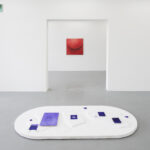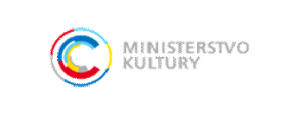Alžběta Josefy
| Date | – |
|---|---|
| Vernissage | 27.04.2023 18:00 |
| Curator | Petr Vaňous |
Alžběta Josefy – hardCORE
Alžběta Josefy has long been fascinated with the painterly essence of material states. Initially, this fascination was expressed through an interest in the external phenomenological aspects of objects and figures – in how, under certain circumstances, changing conditions (light, color reduction, etc.) reveal how these “things” are represented within our attention and how the contours of their substance and the material of their surfaces impacts our gaze and, through it, the movement of our reflexive awareness.
Over time, this interest in situations as materialized and dematerialized painted etudes evolved into an interest in the inner essence of what stands behind the outer form. Josefy began to be drawn to the backsides, the inner folds, and the core of questions from which things sprout, hidden away and obscured, that are only partially seen and perceived by our sensory experience. Since we are speaking of “cores” and the process of “sprouting,” this entire new interest can be compared to an investigation of the relationship between the presumed and actual realizations of what we call form from the viewpoint of the anticipated “life” within the substance.
These principles associated with living organisms – birth and death – are revealed through painting somewhere within the depths of the painted substance.
For Alžběta Josefy, the painting is a relational field of latent processes that must be given form in order to reveal themselves to the human eye. Because they are processes inside the substance of the painting (paint as physical matter), Josefy proceeds both methodically and associatively.
In line with the falsification of what she is looking for in the painting and what she is forming and shaping, Josefy maintains a maximally depersonalized approach to the process of painting in order to give as much room as possible to chance and surprise. In so doing, she reveals the principles of painting itself, such as the qualities of the chosen colors and how these fundamental qualities are transformed into various newfound relationships on the canvas, panel, or paper. Josefy here touches on the “painting-as-such.” She is exploring, with the maximum distance possible for an artist, the chosen colors as material and sensory existences, as minor universes that, in her hands, begin to expand from their original zero-point in all imaginary directions. This activity, which is above all a dynamic process of creation, produces linear and cyclical movements that can be read metaphorically and that constitute analogous states, pictorial model situations that can, with some license, be placed at the beginning of any “creation.”
A dominant factor here is the personification of the gaze as a movement of registration, where registration is a sequence of stages, frozen moments that the artist keeps open as potential horizons of visualized processes. The key factor here is the transformation of the initial epicenter (core, seed) from which the movement in question generally evolves and whose initial form is partially adopted and developed into a symmetry of composition and deformation. This stage can inspire imitation during the creation of utilitarian things.
The next stage involves forms that have already transcended growth and have embarked on the path of decay, destruction, or disappearance. The picture plane accepts these processes as the traces of cyclical formative processes. As the Weimer-era art historian Carl Einstein noted, by definition the emergence of every new form means the destruction of the one that came before; every newly emerging formal vocabulary grows from the substrate of previous layers of form-ruins. Everything is cyclically renewed as a process passes through the gateways of birth and death. A form’s solidity protects the birth of the process, while the processes’ peak and late stages resemble formless chaos and amoebic disruptions.
This tension between the youthfulness and maturity of the substance is a metaphor for a recurring story, a meta-narrative that takes place outside of us, outside of our linguistic naming processes. From a hard core rises a soft and sensitive life, only to again be transformed into the solid parts of a life-giving substrate.
Alžběta Josefy explores this idea as a problem of painting that exists outside of subjective and historical time. Any skepticism vis-à-vis cyclical processes is balanced out by the painted beauty of the twists and turns and dramatic transformations themselves.
Petr Vaňous
Alžběta Josefy (born 1984 in Liberec) studied at Prague’s Academy of Fine Arts in 2007–2013 (Studio of Classical Painting Techniques, prof. Zdeněk Beran; Painting Studio III, prof. Michael Rittstein). Exhibition projects that have helped place her work into the context of the contemporary art scene include RESONANZ (2018, Go Green Art Gallery, Zurich), Confluente (2018, Galateca Gallery, Bucharest), RETINA: The Possibilities of Painting (2020, 8smička, Humpolec), and the solo exhibition Uncertain Incentive (2021, GASK, Kutná Hora). Besides painting, she also works with music.
Wrote about the exhibition



















